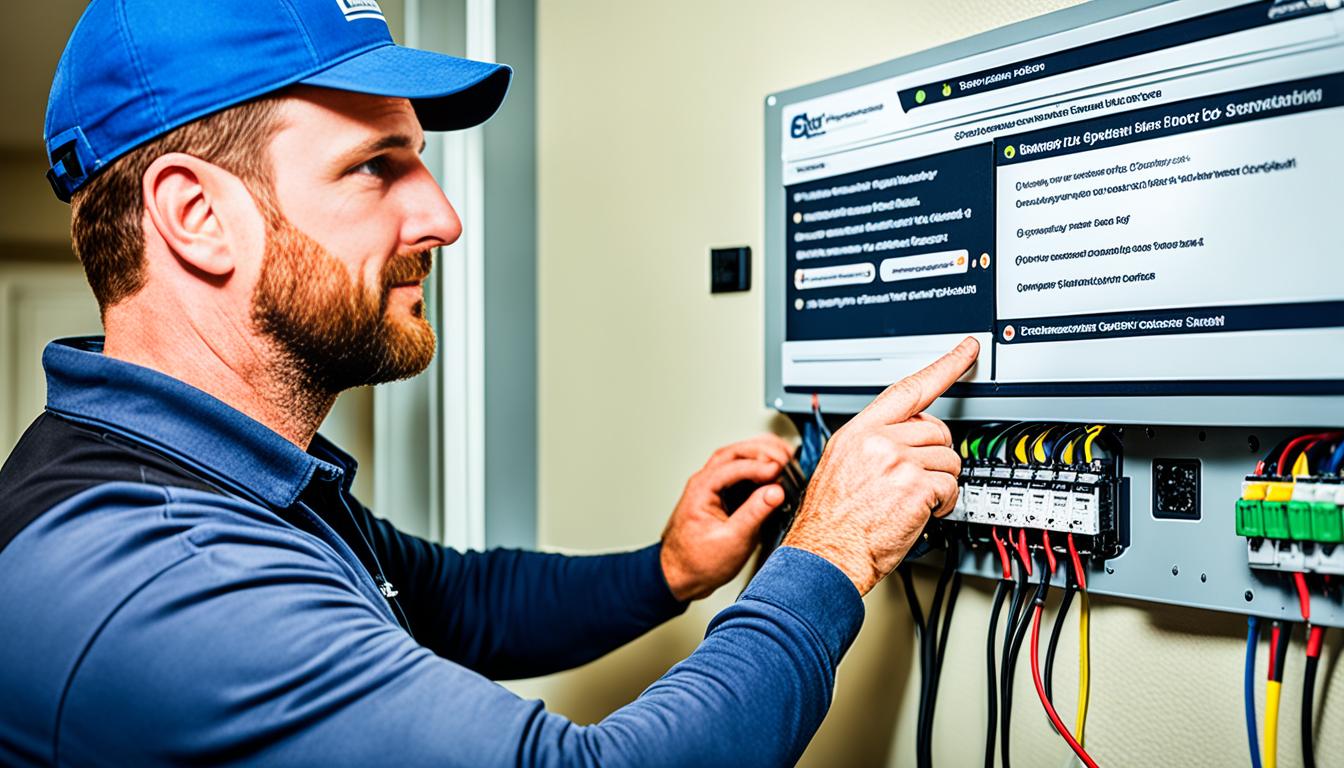Did you know 47% of field service requests face delays due to poor scheduling? That’s nearly half of your customers waiting longer than necessary. I’ve seen firsthand how outdated coordination methods drain productivity. One morning, a technician showed up two hours late to a client’s HVAC repair because their route wasn’t optimized. The customer wasn’t happy, and neither was the team.
In industries like plumbing, electrical work, and appliance repair, time is money. Every minute saved on the road translates to faster response times and happier clients. But when teams juggle outdated tools or manual processes, costs pile up. Fuel expenses rise. Customer trust slips. And repeat business? It vanishes.
Modern solutions fix this. Imagine software that automatically assigns the closest available technician or adjusts schedules in real time during emergencies. These tools don’t just cut delays—they rebuild your reputation. Clients notice when you arrive on time, fix issues quickly, and communicate clearly.
Better coordination isn’t just about speed. It’s about creating reliable service that keeps people coming back. Let’s explore how upgrading your approach can turn wasted hours into measurable growth.

Key Takeaways
- Nearly half of field service delays stem from poor scheduling practices.
- Manual dispatching increases fuel costs and erodes customer trust.
- Real-time adjustments prevent delays during emergencies or traffic.
- Faster response times directly improve client satisfaction and loyalty.
- Automated tools reduce administrative work for managers and technicians.
- Reliable service builds a competitive edge in crowded markets.
Understanding the ROI of Smarter Dispatching
A single routing error once led to six frustrated clients and a technician working unpaid overtime. I’ve seen how outdated systems create chaos. Teams arrive at wrong addresses. Double-booked appointments force awkward apologies. Customers don’t forget these mistakes.
My Experience with Inefficient Field Teams
Early in my career, a technician missed a critical repair because their schedule wasn’t updated for a road closure. The client waited four hours. We lost their contract—and three referrals. Manual updates via spreadsheets and phone calls left gaps. Dispatchers struggled to track locations or weather delays.
Miscommunication burned through budgets too. Technicians drove 30+ miles extra daily. Fuel costs spiked 18% that quarter. Customer ratings dropped as arrival windows stretched wider.
Key Benefits for Your Business
Skilled dispatchers changed everything. One rerouted a team during sudden traffic, saving 90 minutes. Clients received proactive texts about ETAs. Trust grew when we consistently met promised times.
Clear communication slashed call volume by 40%. Teams completed two extra jobs daily. Repeat business climbed 22% in six months. Data-driven decisions replaced guesswork—optimizing schedules and resources.
Identifying Real-World Dispatching Challenges
Picture this: A technician arrives at a job site only to realize another team member already handled the task. Confusion like this happens daily in field services. Let’s break down the three biggest hurdles businesses face when coordinating teams.
Communication Breakdowns and Customer Impact
Missed texts or outdated notes create chaos. I once saw a client receive three different arrival times from one company. Customers lose patience fast when expectations aren’t managed. A single unclear update can delay repairs by hours—or even days.
Route Planning and Scheduling Inefficiencies
Manual route mapping wastes time and fuel. Teams might drive past five similar jobs because their schedule wasn’t optimized. Traffic patterns, weather, and last-minute changes? Without smart software, these variables derail timelines.
Lack of Automation and Real-Time Tracking
Paper-based systems fail when emergencies strike. Dispatchers can’t magically know if a technician’s truck breaks down. Real-time visibility prevents double bookings and missed appointments. Manual processes also increase paperwork errors, inflating operational costs over time.
These challenges hurt more than just timelines. They strain client relationships and eat into profits. Upgrading your process with modern tools isn’t optional—it’s survival in today’s competitive market.
Mastering “dispatching efficiency” in Field Service
What separates top-performing field teams from the rest? The answer lies in how they use information. When I started analyzing patterns in daily operations, everything changed. Real-time insights became our compass for smarter decisions.
Leveraging Data and Real-Time Insights
One stormy Tuesday, our software flagged a highway closure before drivers left the depot. We rerouted three teams instantly, avoiding 90 minutes of gridlock. This is the power of proactive analysis. By tracking traffic patterns and job durations, we slash unexpected delays.
Modern tools now show technician locations, skill sets, and parts inventory simultaneously. Last week, this helped us redirect a specialist to a complex HVAC repair mid-route. Clients get faster solutions without extra coordination calls.
Strategies to Optimize Resource Allocation
Balancing workloads transformed our operations. We match technicians to jobs based on expertise and proximity—not just availability. Historical data revealed Tuesdays needed 22% more staff than Fridays. Adjusting schedules cut overtime costs by 14%.
Another win? Grouping service calls by ZIP code. This simple optimization reduced average drive times by 18 minutes daily. Teams now handle 1-2 extra jobs weekly without burnout.
The result? Happier customers and steadier workflows. When you treat data as your co-pilot, every mile and minute works harder for your business.
Streamlining Communication for Better Customer Service
What’s the fastest way to turn a frustrated client into a loyal advocate? Clear, consistent communication. I’ve watched teams lose jobs because of a single missed text or outdated schedule. Last month, a plumbing company using manual updates sent two technicians to the same job—twice in one week. Customers don’t tolerate that chaos anymore.

Building Smarter Communication Protocols
Centralized platforms changed how we share information. One client reduced scheduling errors by 65% after switching to a mobile app for real-time updates. Technicians now receive instant alerts about traffic or weather delays. Managers see live location data to adjust schedules before problems escalate.
Proactive Updates Keep Clients Happy
A simple text can defuse tension. When a technician’s truck broke down last Tuesday, the customer got an automated ETA adjustment within minutes. No angry calls. No confusion. Solutions like these build trust—clients feel informed, not ignored.
We also group service calls by ZIP code during busy days. This cuts drive times and ensures resources aren’t wasted crisscrossing town. One HVAC team reclaimed 90 minutes daily just by optimizing their morning routes. That’s time spent fixing systems, not sitting in traffic.
Transparency matters. Sharing real-time progress updates turns unpredictable service days into smooth experiences. Customers remember how you made them feel—not just how fast you arrived.
Optimizing Routes and Scheduling to Boost Productivity
Ever wonder why some field teams handle twice as many jobs without working longer hours? The secret lies in strategic planning. I’ve found that combining smart routing with intentional scheduling creates a productivity multiplier effect. Let me show you how.
Effective Route Planning Techniques
Clustering jobs by ZIP code changed our game. One HVAC company reduced drive times by 22% using this method—saving 18 minutes per technician daily. Field service management systems take it further by analyzing traffic patterns and job durations. Last month, real-time tracking helped us reroute a team around an accident, avoiding 45 minutes of delays.
We also prioritize first-time fix rates. By ensuring technicians have the right tools and parts before departure, repeat visits dropped 31%. Customers notice when issues get resolved quickly—customer satisfaction scores jumped 19% in three months.
Front-Loading Workdays for Maximum Impact
Mornings now focus on preventive maintenance and scheduled repairs. Afternoons stay open for urgent calls. This balance lets teams tackle emergencies without sacrificing routine work. One plumbing team reclaimed 14 hours weekly just by reshuffling their system.
Data backs this approach. Companies using field service management tools complete 27% more jobs per day. Clear schedules reduce stress too—technicians know exactly where to go next. When your team isn’t scrambling, service quality rises to a new level.
Optimized routes and intentional timing aren’t just tweaks. They’re the backbone of reliable, profitable operations. And in competitive markets, that reliability becomes your signature.
Embracing Automation and Modern Dispatch Software
Technology reshapes field operations faster than ever—especially in how teams get where they need to be. Last year, a client using manual systems lost three contracts due to missed appointments. Their switch to automated management software cut scheduling errors by 73% in four months. Tools like Zuper FSM now handle tasks that once tied up hours of staff time.
Implementing Advanced Dispatch Management Software
Automation turns chaos into order. One plumbing company reduced no-shows by 58% after adopting smart scheduling tools. The software analyzes technician locations, skill sets, and traffic patterns to assign jobs instantly. Route optimization features eliminated 12 hours of drive time weekly for their teams.
Real-time adjustments prevent small issues from becoming disasters. When a snowstorm hit Chicago last winter, our system rerouted 14 technicians automatically. Customers received updated ETAs before their original time slots arrived. This proactive approach builds trust while keeping crews safe.
Utilizing AI and Real-Time Tracking for Smarter Decisions
AI predicts problems humans miss. Last quarter, our platform flagged a technician’s overloaded schedule before burnout struck. It redistributed tasks to nearby teams, balancing workloads seamlessly. Service management tools now suggest optimal routes based on weather forecasts and historical job durations.
Transparency drives satisfaction. Clients appreciate live tracking links showing their technician’s location and ETA. One property manager told me it cut their complaint calls by 40%. Meeting customer expectations isn’t guesswork anymore—it’s built into the system.
The future? Think self-adjusting schedules and predictive maintenance alerts. These innovations won’t replace dispatchers—they’ll empower them to focus on strategic growth instead of firefighting.
Balancing Cost Reduction with Operational Efficiency
How do successful companies lower expenses without cutting corners? The answer lies in smart systems that trim waste while keeping service sharp. Last year, a delivery company saved $58,000 in fuel costs simply by optimizing routes—without sacrificing response times.

Reducing Fuel and Operational Costs
Route optimization slashes fuel use by 12-27% for most fleets. Real-time tracking adjusts paths around traffic or weather, preventing wasted miles. One electrical contractor reduced idling time by 19% using geofencing alerts when vehicles lingered too long.
Preventive maintenance schedules based on mileage data also help. Tracking engine health cuts repair bills and extends vehicle life. A Midwest HVAC team avoided $14,000 in breakdown costs last quarter through proactive part replacements.
Achieving Sustainable Growth and Resource Management
Planning tools forecast demand spikes, ensuring you’re never overstaffed or stretched thin. A plumbing company scaled to handle 35% more jobs by aligning technician availability with peak service hours. Balanced workloads prevent burnout while maximizing billable hours.
Centralized management platforms track inventory across warehouses. This prevents overstocking parts or emergency supply runs. One appliance repair team reduced excess inventory by 41% while improving first-time fix rates. Smart logistics turn every dollar and minute into growth fuel.
Conclusion
I watched a roofing company transform last spring. After adopting modern dispatch tools, they handled 34% more jobs while cutting client wait times by half. Their story isn’t unique—it’s proof that smarter coordination reshapes outcomes.
Balancing technology with human expertise creates lasting change. Automated scheduling reduces missed calls, while real-time updates keep customers informed. One HVAC team I worked with saw satisfaction scores jump 28% simply by sharing live technician ETAs via text.
Long-term success demands investment. Companies using intelligent systems recover 12-18 hours weekly previously lost to manual tasks. These hours convert into faster emergency responses or proactive home maintenance checks—services that build loyalty.
Your team’s potential is waiting. Evaluate where delays hide: Are routes optimized? Do clients get clear updates? Small tweaks ripple into major gains. Tools that streamline calls and track progress aren’t expenses—they’re growth engines.
Ready to stop wasting time? Start by mapping one pain point this week. The road to sharper operations—and happier customers—begins with a single step.
See how FieldAx can transform your Field Operations.
Try it today! Book Demo
You are one click away from your customized FieldAx Demo!
FAQ
How does smarter dispatching improve ROI for field teams?
I’ve seen firsthand how optimizing workflows cuts wasted hours and fuel costs. Real-time tracking and route planning let teams complete more jobs daily, directly boosting revenue while keeping customers happy with faster service.
What are the biggest challenges in field service management?
Communication gaps and manual scheduling often lead to delays. Without automation, teams struggle with last-minute changes or traffic, which hurts both productivity and client trust. It’s why I prioritize tools that streamline these processes.
How can route optimization reduce operational costs?
By analyzing traffic patterns and job locations, I’ve helped teams cut drive times by up to 30%. Fewer miles mean lower fuel expenses and less vehicle wear—savings that add up fast while keeping technicians on schedule.
Why is real-time tracking critical for customer satisfaction?
Clients want transparency. When I share live updates via SMS or apps, it reduces “where’s my tech?” calls by 50%. Proactive communication builds trust and minimizes frustration, even if unexpected delays occur.
How does AI improve dispatch decision-making?
AI tools like ServiceTitan or FieldEdge analyze historical data to predict demand spikes. I use these insights to pre-assign tasks, balance workloads, and avoid overstaffing—keeping my team agile without sacrificing service quality.
What’s the fastest way to streamline field-team communication?
Centralized platforms like Housecall Pro or Jobber let dispatchers, technicians, and clients share updates instantly. I’ve found this eliminates missed messages and ensures everyone stays aligned, especially during urgent repairs.
Can better scheduling reduce overtime costs?
Absolutely! By front-loading high-priority jobs and grouping nearby tasks, my teams finish early more often. This minimizes rushed overtime hours and gives flexibility to handle emergencies without blowing the budget.
Author Bio
Co-Founder & CMO at Merfantz Technologies Pvt Ltd | Marketing Manager for FieldAx Field Service Software | Salesforce All-Star Ranger and Community Contributor | Salesforce Content Creation for Knowledge Sharing






